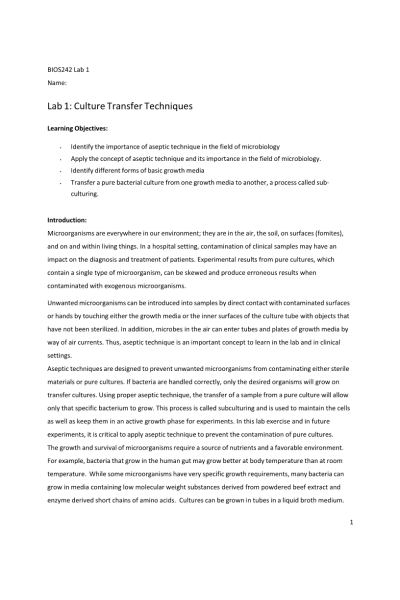BIOS 242 Week 1 Assignment; Lab 1 of 14 Onsite - Culture Transfer Techniques
-
$20.00
| Institution | Chamberlain |
| Contributor | Nikki |
Document Preview
Lab 1: Culture Transfer Techniques
Learning Objectives:
- Identify the importance of aseptic technique in the field of microbiology
- Apply the concept of aseptic technique and its importance in the field of microbiology.
- Identify different forms of basic growth media
- Transfer a pure bacterial culture from one growth media to another, a process called sub- culturing.
Introduction:
Microorganisms are everywhere in our environment; they are in the air, the soil, on surfaces (fomites), and on and within living things. In a hospital setting, contamination of clinical samples may have an impact on the diagnosis and treatment of patients. Experimental results from pure cultures, which contain a single type of microorganism, can be skewed and produce erroneous results when contaminated with exogenous microorganisms.
Unwanted microorganisms can be introduced into samples by direct contact with contaminated surfaces or hands by touching either the growth media or the inner surfaces of the culture tube with objects that have not been sterilized. In addition, microbes in the air can enter tubes and plates of growth media by way of air currents. Thus, aseptic technique is an important concept to learn in the lab and in clinical settings.
Aseptic techniques are designed to prevent unwanted microorganisms from contaminating either sterile materials or pure cultures. If bacteria are handled correctly, only the desired organisms will grow on transfer cultures. Using proper aseptic technique, the transfer of a sample from a pure culture will allow only that specific bacterium to grow. This process is called subculturing and is used to maintain the cells as well as keep them in an active growth phase for experiments. In this lab exercise and in future experiments, it is critical to apply aseptic technique to prevent the contamination of pure cultures.
The growth and survival of microorganisms require a source of nutrients and a favorable environment. For example, bacteria that grow in the human gut may grow better at body temperature than at room temperature. While some microorganisms have very specific growth requirements, many bacteria can grow in media containing low molecular weight substances derived from powdered beef extract and enzyme derived short chains of amino acids. Cultures can be grown in tubes in a liquid broth medium.
Alternatively, the broth can be mixed with agar, a seaweed extract with no nutritional value, to form a semisolid medium. This can be put onto plates or in tubes. In tubes, the agar can either be allowed to harden in the upright position- known as an agar deep or, on a slant, depending on the application.
Slanted tubes of agar provide a larger surface area for growth and are useful for storing specimens for an extended period of time. In contrast, upright agar tubes are used for stab cultures, which can provide information on the organism’s requirement for oxygen.
In this laboratory exercise, Serratia marcescens, a bacteria, will be transferred into a broth culture and to slant and upright (stab) agar media. Both transfer loops and transfer needles will be used. Your instructor will demonstrate how to use the transfer loops and transfer needles using aseptic techniques. You will be using a gas burner so remember to keep hair back and hands away from the flame.
The following transfers will be made, using aseptic technique.
- Broth culture to sterile broth
- Broth culture to sterile slant
- Broth culture to stab culture
- Slant culture to sterile broth
- Slant culture to sterile slant
- Slant culture to sterile stab
Materials:
Nutrient broth, Nutrient agar slants, Nutrient agar stabs, liquid and slant cultures of Serratia marcescens,
inoculating loop, inoculating needle, incinerators
Note to Students:
- You may use metal loops/needles or disposable plastic loops/needles. The instructions may vary based on the type. Please check with your instructor regarding usage and disposal of loops and needles.
- You may use incinerator or burner with flame to sterilize metal loops and needles. Please check with your instructor regarding how to safely use incinerators or burners to sterilize.……….. Continue
| Instituition / Term | |
| Term | Summer |
| Institution | Chamberlain |
| Contributor | Nikki |






























































































